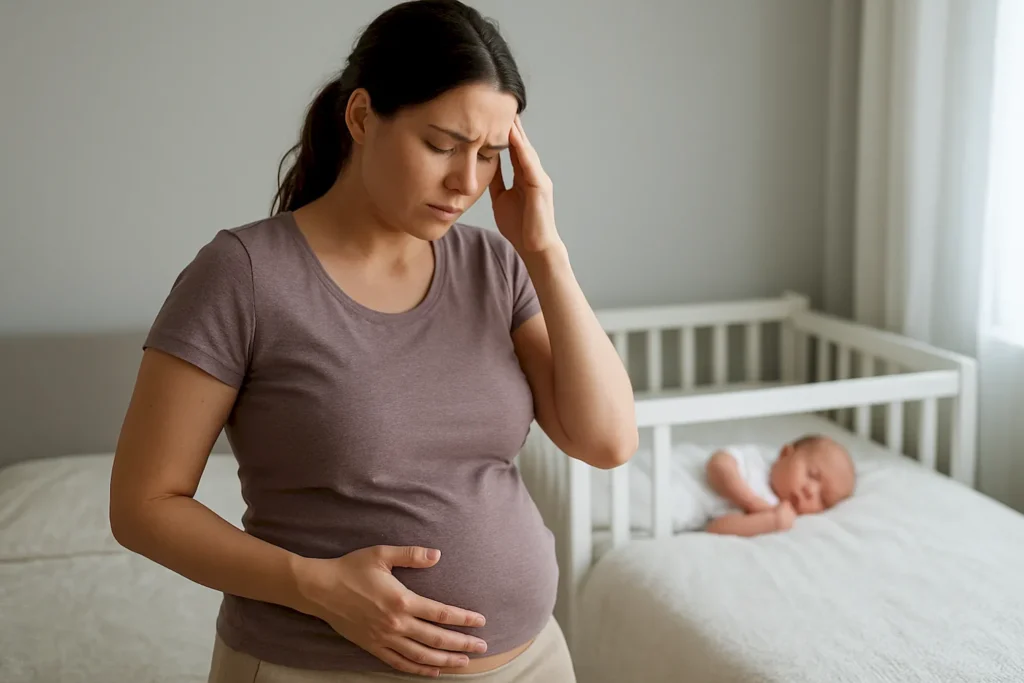After pregnancy belly is a common concern for many new mothers, bringing both physical and emotional challenges during the postpartum journey. This guide offers expert insights on why the belly remains after childbirth, how long it typically takes to shrink, and the safest ways to support healing. From understanding when to seek medical advice to incorporating core-strengthening exercises and postpartum nutrition tips, you’ll find practical, reassuring advice to help you regain strength and confidence. Whether you’re weeks or months into recovery, this article empowers you with knowledge to navigate your postpartum belly recovery with care and confidence.
Why Does the Belly Stay After Pregnancy?
After giving birth, many women notice that their bellies may look and feel different than before. This phenomenon, often referred to as the after pregnancy belly, can be attributed to a variety of factors. First and foremost, the body goes through significant physical changes during pregnancy, which can lead to lingering effects postpartum. Understanding these changes is crucial for mothers who wish to navigate their after pregnancy belly recovery journey effectively and embrace their new bodies.
Hormonal fluctuations play a pivotal role in the postpartum experience. After pregnancy, levels of hormones like estrogen and progesterone decline sharply, and this can impact body composition—particularly in relation to the after pregnancy belly. Additionally, the stretching of the abdominal muscles and skin during pregnancy means it may take time for everything to return to its pre-pregnancy state. Some women may find it challenging to regain their former shape, not only because of changes in body structure but also due to lifestyle adjustments that come with welcoming a new baby. In the end, patience and understanding are essential when dealing with the after pregnancy belly and the overall recovery process.
Common Reasons for Postpartum Belly Retention
- Increased abdominal fat storage associated with hormonal changes.
- Weakened core muscles from stretching during pregnancy.
- Fluid retention, which can persist for weeks after childbirth.
- Diastasis recti, a separation of abdominal muscles that affects many new mothers.
- Changes in pelvic floor strength, contributing to abdominal protrusion.
- Poor nutrition during postpartum recovery can hinder the healing process.
- Inadequate exercise routine, making it challenging to regain core strength.
To address the after pregnancy belly, it’s important to consider the emotional factors at play during this period. The transition into motherhood can be overwhelming and may lead to feelings of inadequacy or pressure to quickly lose weight. These emotional challenges can impact a mother’s motivation to engage in healthy habits, including proper nutrition and exercise. Recognizing and coping with these feelings are vital for postnatal recovery, as they can greatly influence one’s commitment to adopting a healthier lifestyle.
Emotional Factors Impacting Recovery
Many new mothers experience a range of emotions after childbirth, from joy to anxiety. It is essential to recognize the emotional landscape as it directly affects one’s approach to healing. The societal pressure to “bounce back” can lead to unrealistic expectations and unnecessary stress. Self-compassion and support from family or friends can significantly enhance recovery. By embracing a balanced mindset, mothers can focus on healing rather than solely aesthetic results. Remember, healing takes time, and every mother’s journey is unique.
How Long Does It Take for the Belly to Shrink?
After pregnancy, many women are eager to know how long it will take for their after pregnancy belly to shrink and return to its pre-pregnancy appearance. The timeline for this process can vary significantly from one individual to another, influenced by various factors such as genetics, overall health, and lifestyle choices. Generally, it may take anywhere from a few weeks to several months for the belly to start shrinking, with some women noticing changes more rapidly than others. Understanding what contributes to this timeline can help set realistic expectations during the postpartum period.
| Factor | Impact on Shrinkage Time | Example |
|---|---|---|
| Genetics | Affects body shape and how quickly you regain your figure | Family history of postpartum recovery |
| Exercise | Can speed up the process of shrinking the belly | Regular core workouts |
| Nutrition | Healthy eating habits support recovery | Balanced diet rich in vitamins |
| Hydration | Promotes skin elasticity and overall recovery | Drinking adequate water |
During the postpartum phase, it’s also essential to recognize that the belly shrinking process can occur in stages. It is a gradual change rather than an overnight transformation. Many women find it helpful to be informed about the specific stages of belly shrinkage, which can help them monitor their progress and adjust their expectations accordingly.
Stages of Belly Shrinkage
- Initial contraction of the uterus within the first week
- Reduction in swelling and fluid retention over 2-3 weeks
- Fat loss through diet and exercise by 1-3 months
- Restructuring of abdominal muscles around 6 weeks
- The gradual tightening of the skin over 3-6 months
- Final adjustments and lasting changes up to a year
While every postpartum journey is unique, understanding the timeframe for your after pregnancy belly to shrink can help you celebrate the small victories along the way. Taking into account the various factors that can influence this timeline will empower new mothers as they navigate their path to recovery. It’s crucial to combine patience with healthy lifestyle changes, ensuring support for both physical and emotional healing during this transformative period.

Factors Influencing Shrinkage Time
Several factors can significantly influence how quickly your after pregnancy belly can return to its pre-pregnancy state. These include your body’s natural healing capabilities, your activity level, and the method of delivery, which can all play crucial roles in recovery. Additionally, the amount of weight gained during pregnancy and whether you are breastfeeding can also impact the shrinking process. Each woman’s body is different, and recognizing this individuality is vital to maintaining a positive outlook during your postpartum experience.
Considering Medical Options
For some women, despite consistent exercise and healthy habits, the after pregnancy belly may persist longer than expected. In such cases, medical procedures like a tummy tuck after pregnancy can be an option to restore abdominal firmness and contour. It’s important to thoroughly research and consult with a qualified healthcare provider to determine if this route aligns with your personal recovery goals.
Safe Ways to Support Belly Recovery Postpartum
Recovering your belly after pregnancy is a journey that requires careful consideration of both physical and emotional wellbeing. After undergoing the incredible changes during pregnancy, women’s bodies need time and support to heal effectively. Understanding safe methods to promote healing is essential for new mothers as they navigate this transitional phase. Each person’s journey is unique, and finding what works best for you is crucial.
One of the most significant factors in postpartum recovery is to integrate various physical techniques that can assist in tightening and strengthening the abdominal muscles. Engaging in gentle exercises designed to improve core strength can be beneficial, provided they are introduced gradually and with proper guidance. It’s important to listen to your body and give it the time it needs to heal after childbirth.
Recommended Practices for Postpartum Recovery
- Practice deep breathing to engage your core muscles.
- Utilize pelvic floor exercises to enhance strength.
- Incorporate gentle stretches to improve flexibility.
- Choose supportive garments if desired for comfort.
- Maintain daily hydration to encourage overall healing.
- Prioritize rest and recovery in your daily routine.
- Consult with a healthcare professional before starting any new routine.
Another critical aspect of recovery is emotional wellness. Transitioning into motherhood brings a flurry of emotions that can impact how you perceive and care for your body, especially when dealing with changes like an after pregnancy belly. It’s important to address any feelings of pressure related to returning to your pre-pregnancy body. Embracing your body’s transformation and practicing self-compassion can significantly influence your recovery journey.
Emotional Wellness Strategies
Practicing mindfulness and seeking support through community groups can be effective emotional wellness strategies. Connecting with other new mothers can provide a sense of camaraderie, while sharing experiences can ease feelings of isolation. Additionally, consider incorporating relaxation techniques such as meditation or journaling, which can help foster a positive mindset during your postpartum period.
When Should You See a Doctor About Your Postpartum Belly?
After childbirth, many women experience significant changes in their body, particularly in their abdomen. This area, often referred to as the after pregnancy belly, may take time to heal and reshape. While some degree of transformation is normal, it’s crucial to be aware of when these changes may indicate a health concern. A postpartum belly that doesn’t seem to be returning to its pre-pregnancy state could be a typical part of recovery; however, if you notice unusual symptoms or complications, seeking medical advice is essential for your health and well-being.
Warning Signs to Consult a Doctor
- Severe pain or discomfort in your abdomen that feels different from typical postpartum pain.
- Signs of infection, such as persistent fever, redness, or discharge from any incisions.
- Difficulty breathing or chest pain, which could indicate more serious complications.
- Excessive swelling or bloating that does not improve over time.
- If your belly feels firm or hard to the touch and remains that way for an extended period.
- Any unusual changes in bowel or bladder function, which could signal a more significant issue.
It is always best to trust your instincts regarding your body after pregnancy. Taking action early can often lead to more effective treatment options and a quicker recovery. Remember, your health should be your top priority, and never hesitate to reach out to a healthcare professional if something feels off. Open communication with your doctor can provide peace of mind and help you navigate your postpartum journey more effectively.

Nutrition Tips for Healing After Pregnancy
Healing after pregnancy involves more than just time; it requires a thoughtful approach to nutrition. The body needs specific nutrients to recover from the physical demands of childbirth and to support overall health. By focusing on a balanced diet rich in vitamins and minerals, you can promote healing and begin to feel like yourself again.
| Food Group | Examples | Benefits |
|---|---|---|
| Fruits | Berries, oranges, bananas | High in vitamins and antioxidants |
| Vegetables | Leafy greens, carrots, bell peppers | Packed with nutrients essential for recovery |
| Proteins | Chicken, fish, legumes | Supports tissue repair and muscle recovery |
| Whole Grains | Quinoa, brown rice, oats | Provides energy and fiber for digestion |
Focusing on the right nutrition can greatly aid in healing your after pregnancy belly and enhancing your overall well-being. Incorporating diverse foods into your meals ensures you receive a wide range of nutrients. It is essential to listen to your body and eat when you feel hungry, fueling it with wholesome options.
Essential Nutrients for Postpartum Healing
- Protein: Critical for muscle repair and recovery.
- Iron: Supports energy levels and combats fatigue.
- Calcium: Important for bone health and lactation.
- Omega-3 Fatty Acids: Reduces inflammation and supports brain health.
- Folate: Aids in cell division and tissue growth.
- Vitamin D: Enhances calcium absorption and boosts mood.
- Fiber: Promotes digestive health and helps with postpartum weight management.
Meal Ideas for Recovery
Planning balanced meals that include a variety of food groups can make a significant difference in your recovery. Proper nutrition not only fuels your energy but also supports healing of the after pregnancy belly. Simple meal ideas such as a hearty vegetable stir-fry with brown rice or a nourishing smoothie with fruits, spinach, and yogurt can be both easy to prepare and delicious. The focus should always be on whole, nutrient-dense foods that provide the building blocks your body needs during this crucial time of after pregnancy belly recovery.
Exercises to Strengthen Your Core After Birth
After giving birth, many individuals find it challenging to regain their pre-pregnancy core strength, often referred to as the after pregnancy belly. Strengthening your core is essential not only for aesthetic reasons but also for overall physical health. A strong core supports your back, helps with posture, and plays a crucial role in day-to-day activities and postpartum recovery. When working to reduce the after pregnancy belly, it is vital to approach core strengthening exercises with care and focus.
Effective Core Exercises for Postpartum
When beginning your postpartum exercise journey, it’s important to start with gentle movements that gradually build strength. Here are some effective core exercises you can incorporate into your routine:
- Pelvic Tilts: A simple exercise that helps engage your core and lower back.
- Bridges: Strengthens the glutes and core, providing essential support.
- Modified Plank: Focuses on stability without unnecessary strain on the abdomen.
- Bicycle Crunches: Engages multiple core muscles effectively.
- Superman Exercise: Strengthens the back and promotes overall core stability.
- Knees-to-Chest Stretch: Relieves tension while activating abdominal muscles.
- Side-Lying Leg Lifts: Targets the obliques and enhances core strength.
Incorporating these exercises into your daily routine can help in rebuilding core strength and addressing the after pregnancy belly. Always listen to your body and progress at your own pace. Consulting with a healthcare provider or a physical therapist can ensure that you are performing these exercises safely.
Precautions When Exercising Postpartum
While engaging in core-strengthening routines, it’s crucial to observe certain precautions. After giving birth, your body’s structure and capabilities may change, so be mindful of your limitations.
If you experience any pain or discomfort while exercising, stop immediately and consult a professional.
Start slowly, and gradually increase the intensity and duration of your workouts. Additionally, pay attention to your breathing and alignment to prevent any unnecessary strain on your body.






